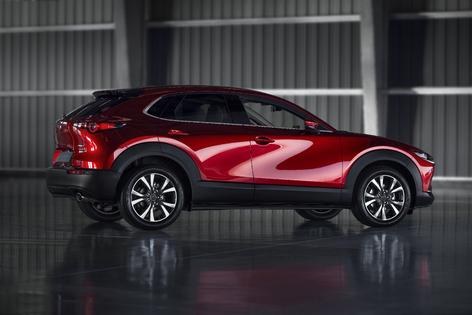Eric's Autos: 2024 Mazda CX-30
Mazda's CX-30 has a couple of things going for it that most of its competitors either charge extra for -- or don't offer at all.
The CX-30 also hasn't got two things that are getting hard to avoid in a new crossover.
What It Is
The CX-30 is Mazda's compact, lowest-priced crossover. It differs from other small crossovers in that it comes standard with all-wheel drive -- and a six-speed automatic (rather than a CVT automatic, a dual-clutch automatic or an automatic with eight or more forward speeds).
It also does not come standard with an undersized engine, turbo-boosted to make up for it. But if you want the most powerful turbocharged engine available in the class -- and for the money -- it's available too.
Prices start at $24,995 for the base 2.5 S trim which -- as the name suggests -- comes standard with a 2.5-liter four-cylinder engine (without a turbo, because it doesn't need one), standard AWD and a six-speed automatic transmission.
If you'd like a turbo to go with that, the new $32,790 2.5 Carbon Turbo has that -- plus a larger (10.25-inch) LCD display, Zircon sand-metallic exterior paint and Terracotta synthetic leather upholstery.
A top-of-the-line 2.5 Turbo Premium Plus stickers for $36,800. It comes with a turbocharged engine, plus adaptive cruise control, a heated steering wheel, a 12-speaker premium Bose audio system, a heads-up display and navigation added to the infotainment system.
What's New for 2024
The Carbon Turbo trim is new -- and enables buyers who want the more powerful turbocharged version of the 2.5-liter engine to get it for less than it cost to buy last year -- when buyers who wanted it had to buy the $33,800-to-start Turbo Premium.
On the downside, the base 2.5 S CX-30's price is up versus last year, when you could buy that one for $22,950.
What's Good
-- Standard engine is big enough -- and strong enough -- to not need a turbo to make up for being too small (and weak).
-- AWD is standard; it's optional in rivals such as the Volkswagen Taos (which also costs several thousand dollars more than the CX-30 when ordered with AWD).
-- Analog controls -- knobs and switches -- can be used to adjust the temperature/fan speed and volume by feel without having to take your eyes off the road.
What's Not So Good
-- Even though it cost about $1,000 less than it did last year, the optional turbo engine is still a very expensive option -- adding almost $8,000 to the 2024 CX-30's MSRP.
-- Rotary mouse control for the audio system requires multiple steps to access the source you want (such as FM or satellite), then another step to select the channel you want.
-- No square-style (old-school) USB charger outlets.
Under the Hood
The CX-30 is unusual in that its standard 2.5-liter, 191-horsepower engine is big enough to be strong enough by itself -- and so doesn't need a turbo to make it strong enough.
Another thing worth a mention in the Mazda's favor is that its standard automatic transmission is a six-speed automatic. Rivals like the VW Taos come standard with an eight-speed automatic; the Hyundai Kona comes standard with a CVT automatic.
Why is that worth mentioning?
Well, a six-speed automatic is a simpler and for that reason inherently more reliable type of automatic than an automatic with eight (or more) speeds. The more a transmission shifts, the more action there is. The odds of eventual problems with all that shifting increase too. And a transmission with speeds rather than ranges (as in a CVT) is also likely to last longer.
If you want a turbocharged engine, Mazda offers that too. The boosted version of the 2.5-liter engine makes a class-highest 250 horsepower.
Equipped with the 250-horsepower engine, a CX-30 can get to 60 mph in the mid-high five-second range, which is quick. The only catch is that this engine only makes its maximum advertised power if you fill the tank with premium unleaded. If you use regular unleaded, the computer that controls the boost will dial the latter down a bit such that the engine only makes 227 horsepower.
But that's still more than you can get in a Taos or a Kona -- irrespective of the fuel you feed them.
On the Road
Forget what's behind you and you can enjoy a drive in a five-door crossover that doesn't feel like driving one. Remember: The same engineers who fine-tuned the Miata's steering and suspension also worked on the CX-30's handling characteristics with the intention of making it feel like a Mazda. That is to say, something that isn't just-another-crossover.
They succeeded.
From behind the wheel, you look out over a sports car-like long hood, and in front of you are sports car-like analog gauges housed in a sports car-like gauge cluster.
When you push down on the accelerator, the Mazda's transmission doesn't need to shift down two (or even three) gears before the thing accelerates -- because it is already closer to being in the right gear for acceleration. Shift-action is nicely snappy when you floor it but also when you're not flooring it.
If only Mazda offered this spunky little crossover with a manual transmission. Then it would be nothing like anybody else's crossover -- and more than just the practical alternative to a Miata.
At the Curb
Practicality is why crossovers have almost completely replaced cars; you can fit more stuff inside the shape -- even if it's the same footprint.
The CX-30 is 173 inches long, which means it has a smaller footprint than a compact sedan such as the current Honda Civic -- which is 184 inches long. But the smaller-footprint Mazda has three times as much total cargo carrying capacity -- 45.2 cubic feet with its second row folded down versus 14.8 cubic feet in the Civic's trunk. Both vehicles have about the same front- and rear-seat legroom for passengers too -- even though the Civic is almost a foot longer.
And the Civic -- which was once an economy car -- isn't cheap anymore, either.
Its base price -- $23,950 -- is almost exactly the same as Mazda asks for the much more practical CX-30, which has enough room for both people and stuff to be a viable family vehicle. A small sedan like the Civic is still a fine commuter/single person's car. But its price is harder to pay when you could buy something like the CX-30 with more room -- and standard AWD -- for about the same money.
The Rest
This Mazda, like most new vehicles, only has the "new" USB charge ports: the rounded ones rather than the old-style rectangular ones. It's not a big deal, because you can use adaptors if you have a phone or other device that uses the old-style hookups. But it is an inconvenience if you don't happen to have an adaptor.
The Bottom Line
Crossovers are, for the most part, like detergent. They're useful, but hard to get excited about.
Here's one that might make you want to do the wash, for once.
========
Eric's latest book, "Doomed: Good Cars Gone Wrong!" will be available soon. To find out more about Eric and read his past columns, please visit the Creators Syndicate webpage at www.creators.com.
Copyright 2024 Creators Syndicate, Inc.








Comments